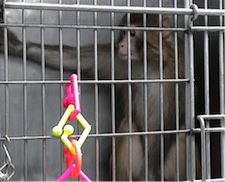
Understanding temperament as a tool for improving welfare
For this quarter’s Animal Welfare feature, Melissa Truelove of the Yerkes National Primate Research Center interviews Dr. Kris Coleman of the Oregon National Primate Research Center about how understanding individual differences in temperament can inform management practices that improve the welfare of laboratory primates.
Melissa: Cage side temperament testing is en vogue; it’s being used to select potential partners for pair housing of monkeys, to select subjects for research, and even to design tailored enrichment devices. You’ve authored several publications on the temperament of primates and its relation to behavioral management practices, as well as measures of animal welfare, the most recent being alopecia. We’d love for you to tell us more about how temperament is being used in the care of laboratory primates.
Why is temperament testing such a hot topic?
Kris: In part, because it is a tool that can be used to identify individuals with certain characteristics, which can allow us to provide personalized “medicine” in a behavioral management context. We know, for example, that very shy, inhibited monkeys are harder to train using standard positive reinforcement training techniques. Knowing an individual’s temperament can help us to identify those at risk for developing behavioral problems, those who may be more challenging to train, and to identify potential housing partners.
Temperament has been studied for a long time and is not a new topic by any means. Researchers have studied temperament or personality in children, primates and other, non-primate species for decades. There are a number of studies showing that temperament can influence many aspects of an individual’s life. For example, studies in children have shown that very inhibited kids are at a greater risk of developing anxiety and depression later in life compared to exploratory children. We also know that temperament can affect behavior in other species; I studied temperament in pumpkinseed sunfish for my dissertation and found that very shy fish took longer to acclimate to laboratory conditions than bold fish. Given these findings, it makes sense that temperament can affect the behavior and well-being of captive primates. I think that what has happened more recently, in the last decade or so, is that temperament testing moved from basic science into applied science, particularly lab animal science. My team, as well as others, has developed simple methods for assessing temperament that do not require dedicated testing space or equipment but can still be performed in a controlled manner. I think the development of these relatively simple assessments has made the study of temperament accessible to laboratory animal professionals who want to use the information that temperament testing results yield.
Melissa: As a leader in temperament testing, what do you see as the most important take-home message when people use cage side assessments?
Kris: There are a few important messages:
- Cage side temperament testing is a tool, but it is not the only tool. There are other ways to assess personality and behavior in animals.
- Temperament is generally defined as an individual’s response to some sort of environmental challenge (such as introduction to a novel object or person); thus, there should be some sort of challenge during the testing. For example, the person interacting with the subject during the test should not be a familiar caregiver.
- Temperament is a stable trait but can still be influenced by experience and environmental conditions. There can be species and even facility differences. Differences in husbandry practices, housing situations and even enrichment can potentially impact temperament.
- Lastly, the test used should address the question you are asking. Cage side temperament assessments have been shown to be useful in identifying individuals who are hard to train, for example. But, they may not be adequate if you are looking for genetics underlying temperament.
Melissa: What are the applications of temperament on welfare? For example, you published a paper about the influence of temperament on the development of alopecia (Coleman et al., 2015). How can that information be applied in a practical manner to improve captive welfare?
Kris: There are a number of ways. If we can help predict animals that are at greater risk for developing problems, then we can intervene early and try to prevent those behaviors from occurring.
We did a study (Coleman, in press) in which we measured the temperament of 3.5 month old rhesus macaques (who were reared in cages with their moms) and then examined their response to imposed weaning several months later. Although most of the animals recovered relatively quickly, those identified as being very shy in our temperament test expressed excessive distress to imposed weaning. Now, if we need to wean infants early (e.g. at 8-9 months), we now assess their temperament first. We avoid imposing weaning on any overly shy infants before at least 1 year of age. This is a preventive measure that we believe helps improve captive welfare.
For another example, we know that positive reinforcement training is a refinement to animal care practices. However, shy animals can be harder to train using positive reinforcement (see Coleman et al., 2005) than exploratory animals, and often seem somewhat anxious during the training. Knowing which animals are shy allows us to try alternate training methods that may be less stressful for them. For example, Clay et al. (2009) found that habituation and desensitization training can reduce fear in macaques. Lisa Houser, Primate Trainer for the Oregon National Primate Research Center, examined whether these techniques could help improve training success in very shy animals. She found that while habituating the animals didn’t dramatically improve training success, it did help to reduce the amount of fear the animals expressed during training (Coleman, in press). Knowing the temperament of the individual can help us to use training methods appropriate for that individual, which hopefully will reduce stress.
If we can identify traits that predict compatibility, then we can preferentially pair-house animals with those traits, and avoid pairing attempts with animals that are likely to be incompatible. We have found that female rhesus macaques seem to be more compatible with those that have a more similar, as opposed to dissimilar, temperament (e.g., Coleman in press).
Another area in which temperament can affect response to behavioral management is with enrichment. Generally, animals are given novel enrichment whenever possible; novelty is often cited as one of the hallmarks of a good enrichment plan. However, highly inhibited animals may be neophobic, and so providing them with constant novelty might be somewhat stressful for them. We might not want to provide novel objects as often to these individuals. We may also be able to help reduce stress for these individuals by trying to make their environment more predictable, for example, by keeping the same care staff in their housing area.
Melissa: Do you foresee another application of temperament that is not being employed at this time?
Kris: What I would like to see is temperament testing of ALL animals, which would allow behavioral management personnel and others to know which individuals are stress sensitive. We could then provide specialized behavioral management care for these individuals, aimed at trying to improve coping strategies.
Melissa: What is the best way to test for temperament in nonhuman primates? Novel object or novel food presentation? Or both?
Kris: It depends on the question you are asking! If you are screening animals to see which will likely be easily trained, you might want to use a novel food object, as that is directly relevant to training. If you are looking at how an animal is going to respond to going into a group, then you might want to use a test that involves a social threat, such as the Human-Intruder test.
It is important to keep in mind the age of the animals, the question(s) you are asking, and the practices that go on at your facility – all will influence the results. Objects that are novel at one facility might not be novel at another, for example. Novel food tends to work well for very young animals, but many adults take just about any food item straight away. However, this may be OK if you are looking to identify the most inhibited individuals.
When selecting a novel object, look for items that will elicit a wide range of behaviors. If every animal is afraid of the object or if every animal inspects it immediately, then it is probably not the best object to utilize for your test. Studies have found that about 10-20% of populations are inhibited; thus you want to pick objects that most, but not all, animals will inspect during the allotted time period.
For additional information, see:
- Capitanio, J. P., Blozis, S. A., Snarr, J., Steward, A. and McCowan, B. J. (2015). Do “birds of a feather flock together” or do “opposites attract”? Behavioral responses and temperament predict success in pairings of rhesus monkeys in a laboratory setting. American Journal of Primatology doi:10.1002/ajp.22464
- Clay, A. W., Bloomsmith, M. A., Marr, M. J., & Maple, T. L. (2009). Habituation and desensitization as methods for reducing fearful behavior in singly housed rhesus macaques. American Journal of Primatology 71(1): 30-39.
- Coleman K. In press. Individual differences in temperament and behavioral management. In The Handbook of Primate Behavioral Management (ed, S. Schapiro). CRC Press.
- Coleman, K., Lutz, C. K., Worlein, J. M., Gottlieb, D. H., Peterson, E., Lee, G. H., Robertson, N.D., Rosenberg, K., Menard, M.T. & Novak, M. A. (2015). The correlation between alopecia and temperament in rhesus macaques (Macaca mulatta) at four primate facilities. American Journal of Primatology doi:10.1002/ajp.22504
- Coleman, K., Tully, L. A., & McMillan, J. L. (2005). Temperament correlates with training success in adult rhesus macaques. American Journal of Primatology 65(1): 63-71.


